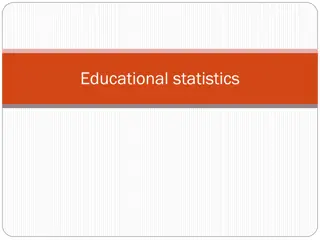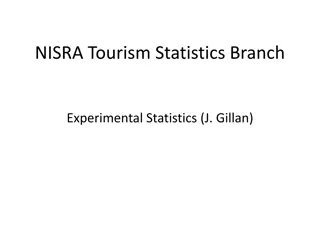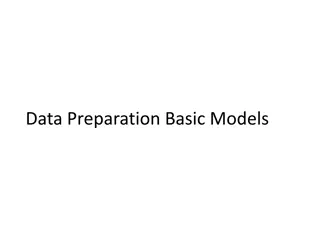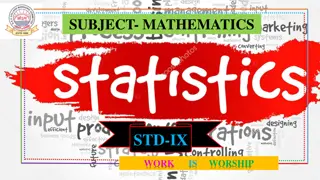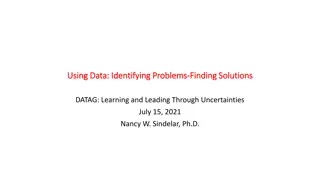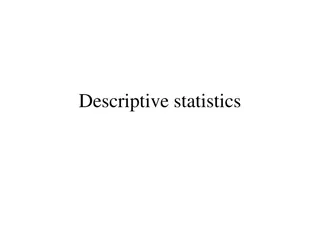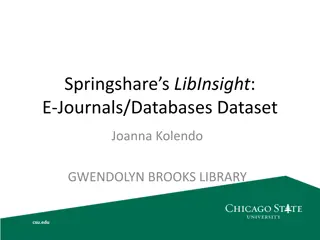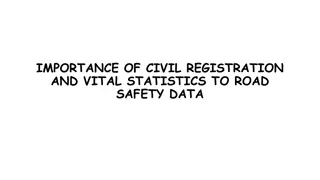Understanding Statistics: The Science and Art of Data Analysis
Delve into the world of data analysis with this lesson on statistics, covering topics such as identifying individuals and variables in a dataset, classifying variables, summarizing distributions, and the statistical problem-solving process. Gain insights into the importance of statistics in making informed decisions based on data.
Download Presentation

Please find below an Image/Link to download the presentation.
The content on the website is provided AS IS for your information and personal use only. It may not be sold, licensed, or shared on other websites without obtaining consent from the author. Download presentation by click this link. If you encounter any issues during the download, it is possible that the publisher has removed the file from their server.
E N D
Presentation Transcript
Analyzing One-Variable Data Lesson 1.1 Statistics: The Science and Art of Data Statistics and Probability with Applications, 3rdEdition Starnes & Tabor Bedford Freeman Worth Publishers
Statistics: The Science and Art of Data Learning Targets After this lesson, you should be able to: Identify the individuals and variables in a data set, then classify the variables as categorical or quantitative. Summarize the distribution of a variable with a frequency table or a relative frequency table. Statistics and Probability with Applications, 3rd Edition 2
Statistics: The Science and Art of Data We live in a world of data. Every day, we encounter data from scientific studies to poll results to test scores to analyses about sports. To understand what the data are saying, you need to learn more about statistics. An understanding of statistics will help you make good decisions based on data. Statistics Statistics is the science and art of collecting, analyzing, and drawing conclusions from data. Statistics and Probability with Applications, 3rd Edition 3
Statistics: The Science and Art of Data Statistical Problem-Solving Process Ask Questions: Clarify the research problem and ask one or more valid statistics questions. Collect Data: Design and carry out an appropriate plan to collect the data. Analyze Data: Use appropriate graphical and numerical methods to analyze the data. Interpret Results: Draw conclusions based on the data analysis. Be sure to answer the research question(s)! Statistics and Probability with Applications, 3rd Edition 4
Statistics: The Science and Art of Data Roller Coaster Type Height (ft) Design Speed (mph) Duration (s) Wildfire Wood 187 Sit Down 70.2 120 Skyline Steel 131.3 Inverted 50 90 Goliath Wood 165 Sit Down 72 105 Helix Steel 134.5 Sit Down 62.1 130 Banshee Steel 167 Inverted 68 160 Black Hole Steel 22.7 Sit Down 25.5 75 Values of a Variable Individual Individual, Variable An individual is a person, animal, or thing described in a set of data. A variable is any attribute that can take different values for different individuals. Statistics and Probability with Applications, 3rd Edition 5
Statistics: The Science and Art of Data Variable A variable is any attribute that can take different values for different individuals. Categorical Variable Quantitative Variable A quantitative variable takes number values for which it makes sense to find an average. A categorical variable assigns labels that place individuals into particular groups. Statistics and Probability with Applications, 3rd Edition 6
Statistics: The Science and Art of Data Categorical Variables Roller Coaster Type Height (ft) Design Speed (mph) Duration (s) Wildfire Wood 187 Sit Down 70.2 120 Skyline Steel 131.3 Inverted 50 90 Goliath Wood 165 Sit Down 72 105 Helix Steel 134.5 Sit Down 62.1 130 Banshee Steel 167 Inverted 68 160 Black Hole Steel 22.7 Sit Down 25.5 75 Quantitative Variables Statistics and Probability with Applications, 3rd Edition 7
Will you show me the money? Will you show me the money? Individuals and Variables Individuals and Variables Statistics and Probability with Applications, 3rd Edition 8
Will you show me the money? Will you show me the money? Individuals and Variables Individuals and Variables SOLUTION: (a) The individuals are the 5 top domestic grossing movies according to Box Office Mojo in a recent year. The four variables measured are: year (of initial release), studio, adjusted gross earnings, and genre. (b) Studio and genre are categorical. Adjusted gross and year are quantitative. Statistics and Probability with Applications, 3rd Edition 9
Statistics: The Science and Art of Data A variable generally takes values that vary from one individual to another. The distribution of a variable describes the pattern of variation of these values. Distribution The distribution of a variable tells us what values the variable takes and how often it takes these values. Statistics and Probability with Applications, 3rd Edition 10
Statistics: The Science and Art of Data We can summarize a variable s distribution with a frequency table or a relative frequency table. Frequency Table A frequency table shows the count of individuals having each data value. Relative Frequency Table A relativefrequency table shows the proportion or percent of individuals having each data value. Statistics and Probability with Applications, 3rd Edition 11
Who wants to party? Who wants to party? Frequency and relative frequency tables Frequency and relative frequency tables Statistics and Probability with Applications, 3rd Edition 12
LESSON APP 1.1 On the first day of a statistics course, the instructor gave all 40 students in the class a survey. The table below shows data from the first 10 students on the class roster. What are my classmates like? Homework Last Night (min) 0-14 Have a Smartphone ? Y Pulse Rate Dominant Hand Children in Family Sleep (hours) Gender Class GPA F Fr 3.22 72 R 3 10 F Fr 2.3 110 L 3 0-14 8 N M Ju 3.8 60 L 6 15-29 7 Y M So 3.1 72 R 2 15-29 7.5 Y F So 4 51 R 1 45-59 7 Y F So 3.4 68 R 4 0-14 8.5 Y F So 3 80 R 3 30-44 7 Y M So 3.5 59 R 2 30-44 7 Y M Fr 3.9 65 R 2 15-29 6 Y M Sr 3.5 144 R 2 0-14 7 N Statistics and Probability with Applications, 3rd Edition 13
LESSON APP 1.1 What are my classmates like? Statistics and Probability with Applications, 3rd Edition 14
Statistics: The Science and Art of Data Learning Targets After this lesson, you should be able to: Identify the individuals and variables in a data set, then classify the variables as categorical or quantitative. Summarize the distribution of a variable with a frequency table or a relative frequency table. Statistics and Probability with Applications, 3rd Edition 15







